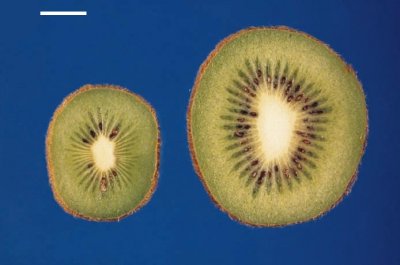Pollination, followed by pollen tube growth and fertilisation, instigates fruit growth (Figure 11.1). If pollination does not occur, flowers are shed (only rare exceptions). Nevertheless, a developmental program of gene expression for fruit growth has already been established well ahead of floral biology. Primordia may have been initiated up to 6 months before a particular flower opens, and ovary development continues during flower growth with ovary tissues forming late in this process. As part of that outcome, homology between leaves and sepals is noteworthy and evident in many fruit (Gillaspy et al. 1993). Sepals show leaf-like cell layers, stomata and chloroplasts.
The generic term ‘fruit’ covers a wide range of structures, all supporting and protecting seeds, but where the various parts have developed from the original fertilised flower in various distinctive ways. In the simplest form, ovary walls grow along with seeds, and as they develop, the ovary walls dry out to become a pod (legume) or capsule (poppy). In others (particularly fleshy fruit), the main structure can arise by exaggerated development of a particular part of the original floral unit. These include ovary wall or central axis, the receptacle that supports anthers and ovary, or even petals and sepals. In morphological terms, fruit are structures that develop from fertilised or stimulated ovules, plus associated floral parts that originate from the parent plant.
Mechanistically, a fruit is a single dispersal unit that includes seeds and associated tissues, developed as a single body. This broad description includes structures derived from a single ovary (as in simple fruit such as apple, avocado and mango) as well as compound fruit where separate ovaries are joined (an aggregate fruit such as blackberry and cherimoya) or where separate flowers are collected into a single structure (pineapple and breadfruit).
During fruit development, an ovary wall becomes a pericarp: either dry as in a dehiscent pea pod and the indehiscent caryopsis of barley, or fleshy as in berries (grape). Three morphologically distinct strata are present and developed to varied degrees: exocarp (fruit skin), mesocarp (fruit flesh) and endocarp (inner cell layers).
An exocarp will develop a cuticle and may exhibit a variety of morphological features such as coarse hairs (kiwifruit) or fine hairs (peach). The exocarp plus cuticle restricts gas exchange, and determines the general appearance of ripening fruit. Most cuticles are highly impermeable to gases, so that water vapour, O2 and CO2 diffuse mainly via either stomata or lenticels or by mass flow through cavities at the calyx and stem ends of fruit.
Mesocarp tissues usually represent the fleshy part of a fruit, and commonly hold chloroplasts and starch grains. In fleshy fruit such as berries (e.g. tomato, kiwifruit and grape) this tissue typically comprises large parenchyma cells and contains the main vascular network.
Endocarps are less common, but typically develop as a dense hard case around a seed, as in peach, apricot or macadamia.
An ovary must be stimulated in some way for fruit growth to occur; this is normally by pollination and fertilisation. Gibberellins and auxins are involved in the pollination stimulus, and subsequent hormone production by the fertilised ovary is critical to stimulating fruit development (de Jong et al. 2009).
By implication, a suitable balance of growth regulators applied to unpollinated fruitlets can result in fruit set, and in practice gibberellins GA4 and GA7 are very effective in setting parthenocarpic (seedless) apple fruit. By contrast, parthenocarpy is rare in kiwifruit, although repeated applications of napthaleneacetic acid (NAA) with benzyladenine (BA) and gibberellin have been successful. Such results confirm that growth regulators — alone or in combination — can trigger cell division in ovaries or related tissues that ultimately become fruit.
Seedless fruit have arisen via human selection of genotypes in which ovaries produce an adequate supply of growth regulators without any stimulation from the germinating pollen and developing seed (triploid banana), or where fertilisation is closely followed by seed abortion (stenospermocarpic, as in sultana grape). In the absence of pollination, levels of endogenous hormones such as auxins and gibberellins normally fall markedly (de Jong et al. 2009) and flowers abscise or fruitlets stop growing.
